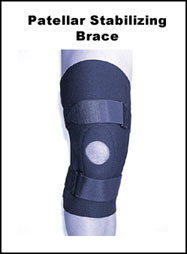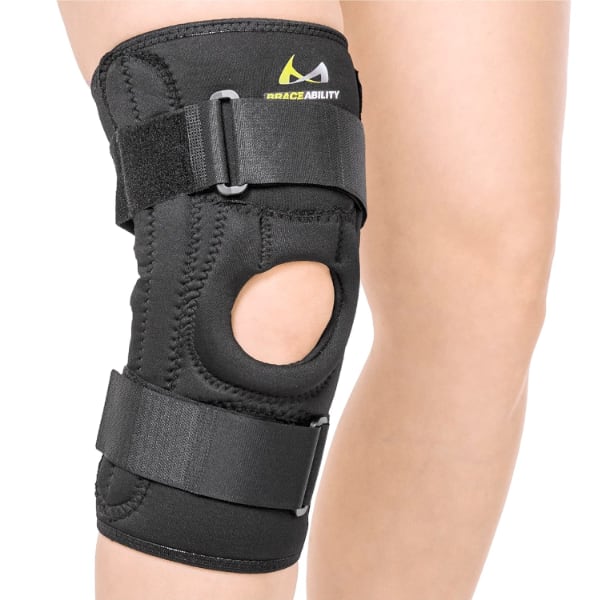In order to understand the way patellar stabilizing braces work it is important to understand the anatomy and function of the knee and the knee cap (patella). Please review the section on knee anatomy and on patellar dislocations and patellar instability prior to reviewing this section. You should also review the more specific section on the basic anatomy of the patellofemoral joint.

When the patella comes completely out of the femoral groove it is called a patellar dislocation. Occasionally the patella will only partly come out of the groove. This is called a patellar subluxation. Patellar subluxations can be thought of as “mild dislocations”. Most of the time the patella dislocates or subluxes outward (laterally). The medial patellar ligament and the vastus medialis muscle are important structures in preventing the patella from dislocating or subluxing laterally. When the patella dislocates or subluxes laterally, these structures are usually damaged. As a result of one or more patellar dislocations or subluxations the knee can feel unstable. This type of problem is called patellar instability. This feeling of instability occurs because the muscles and ligaments are unable to keep the patella in the groove.
What is a patellar stabilizing brace?
Patellar stabilizing braces are designed to help keep the patella in the femoral groove after a patellar dislocation or subluxation. Patellar stabilizing braces may reduce the chance of another patellar dislocation or subluxation and may also help reduce the feeling of instability. After a patellar dislocation or subluxation the long term goal is to return the individual back to their previous level of activity. A general knee rehabilitation program which includes strengthening exercises, flexibility exercises, aerobic conditioning, technique refinement and proprioceptive (biofeedback) retraining is the most important factor in achieving this goal. Some people with patellar instability report an improved sense of stability when wearing a patellar stabilizing brace.
What are the different types of patellar stabilizing braces?
There are many different types of patellar stabilizing braces available. They are usually made of neoprene and many have straps or pads (buttresses) that help keep the patella in place. As mentioned above, the patella usually dislocates or subluxes laterally so the buttress is placed laterally to push the patella inwards (medially). Patellar stabilizing braces come in a variety of sizes with or without hinges for additional support. The effectiveness of a patellar stabilizing brace depends on a correct fit and use.
What do patellar stabilizing braces do?
Patellar stabilizing braces are designed to reduce knee instability following a patellar dislocation or subluxation. They are usually recommended for twisting, pivoting, cutting or jumping activities. In addition to providing increased stability to the patella, patellar stabilizing braces may also decrease the risk of injuring other parts of the knee.
What are the disadvantages of patellar stabilizing braces?
Patellar stabilizing braces have some drawbacks. Some people report that they are hot, cumbersome and sometimes the brace material can irritate the skin. Patellar stabilizing braces can also be expensive. Furthermore, patellar stabilizing braces do not always work. Sometimes they do not improve the stability of the injured knee especially when the patella is very unstable or if there are other significant ligament injuries to the knee. Patellar stabilizing braces do not return normal stability to the knee, so the knee may still feel unstable under high forces. However, when patellar stabilizing braces are fitted properly and when used in conjunction with a general knee rehabilitation program these braces can serve a role in the treatment of patellar dislocations or subluxations.
How do I know if I need a patellar stabilizing brace?
Doctors and physiotherapists who are skilled in treating patellar dislocations or subluxations can advise whether a brace would be helpful and how to get the correct brace. Patellar stabilizing braces should be considered as part of the treatment of patellar dislocations or subluxations.
Please visit the links section for additional information on patellar stabilizing braces. Links have been provided to other websites as well as online medical journals. Other knee injury topics can also be accessed.
A recommended Patellar Stabilizing Brace:

BraceAbility Patella Stabilizing Chondromalacia Knee Brace – Patellofemoral Pain Syndrome
- U-SHAPED PADDED BUTTRESS – Improve patellar tracking, support and stabilization of the inner and outer kneecap with this chondromalacia wrap. The buttress helps reduce strain on the cartilage beneath the kneecap.
- LIGHTWEIGHT, COMFORTABLE SUPPORT – Made of breathable neoprene alternative, which allows heat and moisture to escape, making this knee brace the best option for an active lifestyle. Use during physical activity, walking, running, exercising, cycling, and hiking!
- CONVENIENT, PULL-ON STYLE – Quick and easy to apply, this medial knee pain brace is pulled on like a sleeve, with adjustable compression straps which help prevent any sliding down of the patellar immobilizer sleeve while you are active.
- TREATS AND MANAGES PATELLA PAIN – Use for a variety of knee pain and conditions such as tendon tears, patella alta/baja, chondromalacia, knee bursitis, dislocation, floating kneecap, runner’s and jumper’s knee, subluxation, knock knees, bowed legs and more! .
